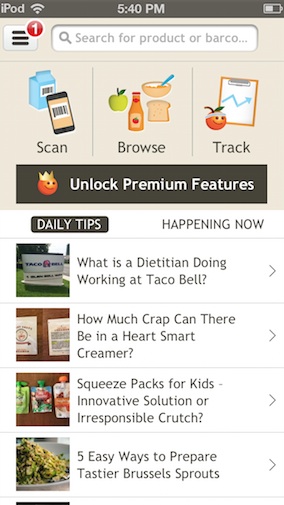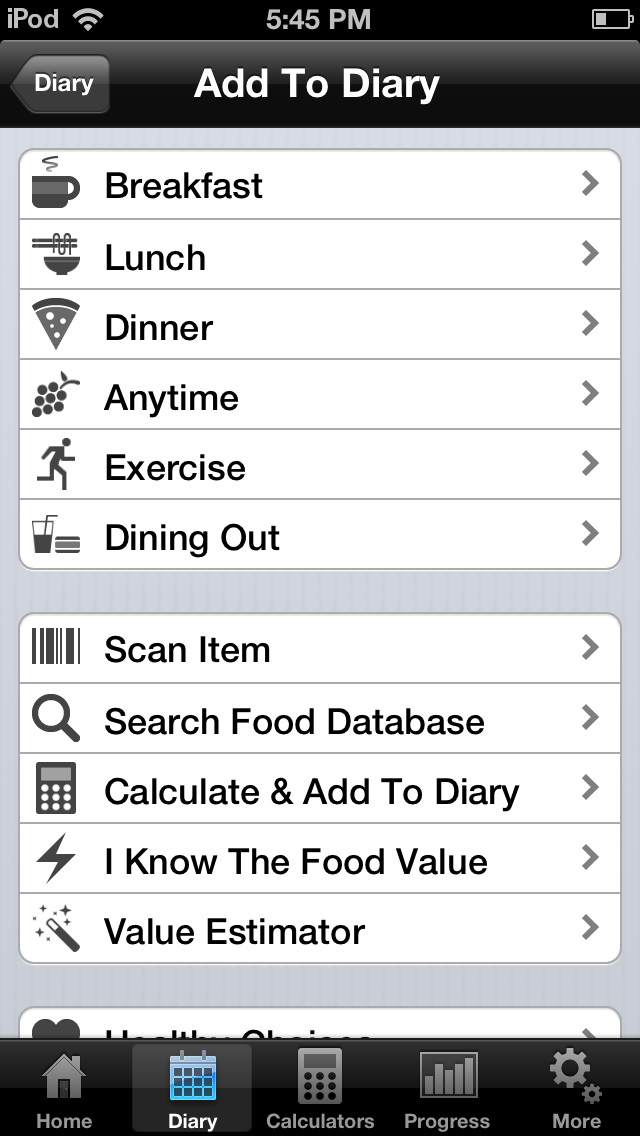Diet Tracking Apps Use Barcode Scanning
 Did you make a New Year’s resolution to lose weight, get fit, eat better? Did you stop actively working towards that resolution weeks ago? Maybe you’re one of the few who’s still on course or you don’t believe in New Year’s Resolutions at all—maybe you just want to hold yourself accountable for your food-related decisions. Luckily, there’s an app for that. In fact, there are numerous apps. Here are a few that use barcode scanning to help you stay on track.
Did you make a New Year’s resolution to lose weight, get fit, eat better? Did you stop actively working towards that resolution weeks ago? Maybe you’re one of the few who’s still on course or you don’t believe in New Year’s Resolutions at all—maybe you just want to hold yourself accountable for your food-related decisions. Luckily, there’s an app for that. In fact, there are numerous apps. Here are a few that use barcode scanning to help you stay on track.
Ultimate Value Diary. (see lower right photo) The Ultimate Value Diary starts by asking you some basic information: name, date of birth, gender, height, and weight. The app uses this information to calculate how many “points” you are allowed to consume per day. After exiting a nicely implemented tutorial overlay, you can then start tracking your meals by scanning an item’s barcode, searching for a non-barcoded food such as “apple,” or manually inputting the nutritional information you know in order to estimate the food’s point value. It’s simple, especially if you’re mostly eating packaged food. When I went through my cupboards scanning barcodes, it wasn’t until I tried a discontinued holiday-flavored bottle of seltzer that I was able to stump the app.
My only issue with the Ultimate Value Diary app was that I, personally, don’t think in terms of “points” when it comes to food. I’ve never tried weight watchers or any other diet program that calculates food values in such a way. So when the app tells me that my morning bowl of steel-cut oats with almond butter and soy milk uses up nearly half of my allotted points for the day despite my knowing that it contains only about 300 calories, something feels fishy. Of course, further exploration of the app shows that there are plenty of foods worth zero points. These “free foods” include apples, steamed vegetables, lettuce, and the like, and are highlighted in eye-catching green when appearing in a search. According to the app’s FAQ, the point value of foods is determined by the food’s protein, fat, fiber and carbohydrate content. If you prefer to think in terms of points instead of calories—or think you could get used to points—then this app is definitely worth checking out.
There’s also a neat option, enabled by default, where you can have your remaining points displayed as a badge on the app’s icon. I thought that was a nice touch—though I’ll admit for a confused moment I thought the app was indicating it needed fifteen updates. You can also earn additional points by recording exercise sessions, which is a simple process of entering how long you exercised and at what intensity. You have the option of incorporating these extra points into your daily allowance, or ignoring them.
The Ultimate Value Diary app is available for $3.99 for iPhones and iPads, and $2.99 for Android devices, Google Play and the Barnes and Noble Nook.
Fooducate. (top left photo) The Fooducate App has a more intensive sign-up process; you can log in via Facebook or open an account requiring email verification. Then there’s the age-sex-height-weight calculation for your BMI, and if you want to lose weight you’re asked to enter your target weight and the rate at which you’d like to lose. Your target daily caloric intake is then calculated based on these factors. Yes, calories, though each food is also given a “FoodPoints” value for dieters.
With the Fooducate app, you can scan barcodes or search for foods by name, category, etc. Additionally, every item is given a grade between D and A, and these grades are color coded: red, yellow and green. The colors mean exactly what you’d expect. If the Fooducate’s algorithmic sensibilities are in line with your own, this gives you a easy eye-catching way to immediately categorize any item as an always, sometimes, or almost never food.
Fooducate is free for both Android and iOS—unless you want access to their premium options or capabilities. You can buy premium service for $3.99 for three months, $6.99 for a year, or $9.99 for a lifetime subscription. A sampling of what premium service will get you: the ability to track additional goals such as “eat healthy while pregnant” or “lower my blood pressure”; the ability to track additional nutritional information such as the amount of fat, sodium, protein and dietary fiber in the food you eat. If you have food allergies or live a gluten-free lifestyle, there is a different upgrade available for $4.99 for three months, $12.99 for a year, or $14.99 for a lifetime.
Fooducate is a perfectly functional app without the premium service, though I found it distracting how often I bumped up against offers to upgrade. But all’s fair in love, war, and free services, right? Plus, it was the only app I tested to correctly identify the discontinued seltzer.
ShopWell. The ShopWell app is a different sort of beast. No calorie or point tracking—this is purely a food shopping app. You sign up and fill out a profile that includes your gender and age range and any dietary preferences. The preference options are wide-ranging. Under “Goals” you can select options such as athletic training, weight management, or managing anemia or high blood pressure. The goals you select will automatically mark certain nutrients in the “Wants” menu, and you can indicate any additional preferences there, such as for folic acid or whole grains. Under “Don’t Wants” you can select to avoid artificial sweeteners, lactose, preservatives, etc. There is also a separate “Avoids” menu for allergies and intolerances.
After completing your user profile, you either hit up the grocery store with the app’s barcode scanner or browse ShopWell’s massive index of items. Each item you scan or select has a rating on a 1-100 scale depending on your indicated preferences and needs. It’s not a foolproof system. For example, I put in a preference for high protein, folic acid and limited added sugar, and a breakfast drink with 26 grams of sugar per serving (52 per seemingly serving-sized bottle) came up as a “strong match.” To my way of thinking, that amount of sugar completely offsets the positives of the drink. By the app’s way of calculating, not so. But, the ShopWell grading system is still a good way to get an at-a-glance appraisal of items and you can take it from there. Plus, it’s free—with no obvious strings attached.
In summary, it’s unlikely that any food tracking or barcode scanning app is going to magically make you lose weight or make it so you never again falter when it comes to eating healthfully. That being said, each of the above apps has the potential to serve as a useful tool in the unending quest for a healthy lifestyle.
By Alex Mehler
Related Articles:
LoveList App Scans Physical Products to Pin on Pinterest
ShopSavvy Unveils New Version of Mobile Shopping Platform to Empower Product and Store Discovery
Shopsavvy application for iPhone and Android
Scan Bar Codes With Your Tablet: A Review of Popular Apps
Axicon Labels to Launch New Labelling Service at Foodex 2014
